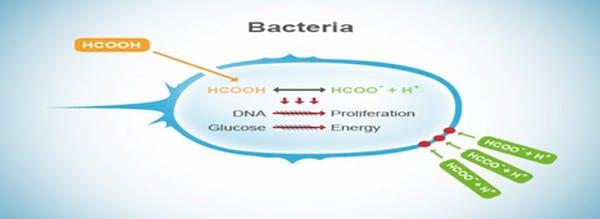Due to the vast expansion of poultry industry challenges also increases. One of them is the control of microbial population which is done by excessive use of therapeutics antibiotics and AGP’s. The indiscriminate use of these products results in the emergence of antibiotic resistance. Apart from resistance it also leads to public health concern. Due to this EU has banned the use of AGP’s in 2006. After that, researchers found different ways to combat the problem of microbial control. Among these is the use of organic acids, probiotics, prebiotics, Essential oils, bacteriophages etc. among these organic acids have gained much attention in this regard because they have antimicrobial activity against pathogenic bacteria and improves the nutrient digestion and absorption by several mechanisms.
What is organic acid
An organic acid is a carboxylic acid including fatty acid having the formula R-COOH with acidic properties.
Most commonly used organic acid are short chain fatty acid e.g. formic acid, propionic acid, butyric acid, acetic acid, citric acid and malic acid which is a dicarboxylic acid. These all are usually weak organic acids which when dissolved in water changed into their hydrogen and hydroxyl ion respectively. The working and mode of action of these acids are dependent upon their PH and Pka value. Pka is a value at which 50% of acid is present in dissociated form. Only in its undissociated form an organic acid crosses the cell wall of bacteria and perform its antimicrobial activity. This means that these organic acids have much pronounced activity in acidic environment e.g. in the stomach and reduced activity in alkaline environment e.g. in the small intestine.

Accordingly, organic acids with a high pKa value are weaker acids and therefore more effective preservatives for feed, as, being present in the feedstuff with a higher proportion of their undissociated form, can defend feed from fungi and microbes. Therefore, the lower the pKa of the like formic and lactic acid are used for improving digestibility process in animals. organic acid (the higher proportion of dissociated form) the greater is its effect on the reduction of stomach pH and the lower its antimicrobial effect in the more distal portions during its transit through the digestive tract. A strong acid (with low pKa) will acidify the feed and the stomach, but will not have strong direct effects on the microflora in the intestine. This is the reason why acid like propionic acid with higher Pka value is used as preservative of feed, while acid with lower Pka
Mode of action
The undissociated form crosses the lipid cell wall of the microbe. The higher cellular PH causes the dissociation of acid releasing its H+ ions which lower the PH of microbial cell. The lower PH has a deleterious effect on various metabolic processes including DNA replication. Microbial cell uses energy to counteract this PH lowering effect which leads to exhaustion and eventual death of microbe. The remaining anions(-COOH) also have negative effects on cell critical metabolic processes.
Benefits of using organic acid in animal nutrition
Killing of microbes especially gram negative (Salmonella, E. coli) in drinking water and in the intestine leads to better utilization and absorption of feed which results in better weight gain and FCR. The PH lowering effect hampers the growth of pathogenic microbes.
Prevent biofilm formation in the drinking systems thus minimize the pathogen load in water.
Increase the digestibility of nutrients especially proteins by its pronounced PH reducing effect in the stomach which enhance the release of pepsin which is a protein degrading enzyme.
Increase the pancreatic secretions result in better digestion and metabolism of fat.
Delay the gastric emptying time of feed result in better nutrient absorption.
They serve as intermediary substrates (butyric acid, citric acid) in the different cycles of metabolism thus act as a direct energy source for the bird. Several research trials have shown the positive effect of butyric acid in reducing the Salmonella population in the intestine presumably by inhibiting the synthesis of pathogenic factors by salmonella. Butyric acid is an intermediary metabolite in the energy cycle in enterocytes thus it maintains the performance and integrity of the enterocytes.
Reduce the incidence of diarrhea and subclinical enteritis.
Enhance the absorption of minerals (P, Cu, Zn)
Alternatives to AGPs to reduce medication cost.
NEW STRATEGIES FOR organic acids have been developed for its better functioning in the intestine. These strategies include encapsulation of organic acid. The encapsulation process ensures the targeted release of acid in the small and large intestine where major pathogenic load of microbes are present. Another strategy is the use of glyceride of acid. In this process, organic acid is attached (esterified) with glycerol. This combination protects the acid from degradation by the stomach PH. Once these glycerides are reached in the small intestine lipase enzyme breaks the bond and acid is released.
Use of a combination of the organic acid is another strategy used. Because as stated earlier different organic acids have different pka values so they behave differently along the tract. The purpose of using combination is to maximize the effects along the tract. Use of salts of organic acids e.g. potassium formate is also common. Use of salt of acid reduces the bitterness and corrosiveness of acid.
Conclusion
Organic acids have potential to use as an alternative to AGPs. They reduce the medication cost improves animal performance and production parameters, have a broader spectrum of activity. Use of technology further enhances their effectiveness.
References:
H. M. A. Hassan*, M. A. (October 2010). Effect of Using Organic Acids to Substitute Antibiotic Growth Promoters on Performance and Intestinal Microflora of Broilers. Asian-Aust. J. Anim. Sci. Vol. 23, No. 10, 1348 - 1353.
Ján Kopecký, C. H. (2012). Effect of Organic Acids Supplement on Performance of Broiler Chickens, Slovak University of Agriculture in Nitra, Faculty of Agrobiology and Food Resources, Department of Poultry Science and Small Animal Husbandry, 949 76-Nitra, Tr. A. Hlinku, 2, Slovak. Animal Sciences and Biotechnologies, 51-54.
María Alejandra Pérez-Alvaradoa, J. C. (n.d.). Organic Acids, with emphasis on Benzoic Acid, to rationalize the use of therapeutic antibiotics.
P. Chaveerach, *. D. (2004). Effect of Organic Acids in Drinking Water for Young Broilers on Campylobacter Infection, Volatile Fatty Acid Production, Gut Microflora and Histological Cell Changes. Poultry Science, 330-334.
S.N.S Silva, A. P. (2016). in vitro efficacy of four sodium salt of organic acids against E.coli isolated from poultry outbreaks in Sri Lanka. The World Poultry Science Association, 16-18.











.jpg&w=3840&q=75)







.jpg&w=3840&q=75)